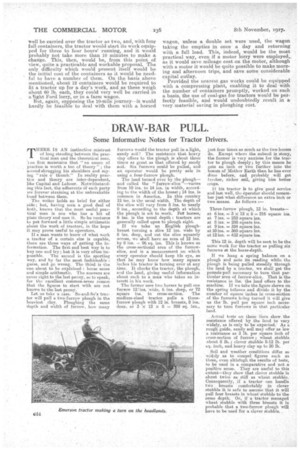• DRAW-BAR PULL.
Page 14

If you've noticed an error in this article please click here to report it so we can fix it.
Some Informative Notes for Tractor Drivers.
THERE IS AN instinctive mistrust of long standing between the prac
• tical man and the theoretical mail. 'ins first maintains that " an ounce of practice is worth a ton of theory " ; the Second shrugging his shoulders and saying "rule a thumb." In reality practice and theory are inter-dependent, like Capital and Labour. Notwithstanding this fact,the adherents of each party Are forever straining at the unbreakable bond between them.
The Writer holds no brief for either side ; but, having seen a good deal of both, knows that the most useful practical man is one who has a bit of plain theory and uses it, So he ventures to put forward a little simple arithmetic about the work of tractors, in the hope it may prove useful to operators.
If a man wants to know of what work tractor of a certain size is capable, there are three ways of getting the information. The first and best way is to buy one and try ; but it is very often ii
possible. The second is the sporting way, and by far the most fashionable : guess, and go wrong.. The third. is the nob about to be explained : horse reuse and simple arithmetic. The answers are never right to the last penny, so to speak, for the excellent common-senee reason that the figures to start with are not known to the last penny:
Let us take a case. So-and-So's tractor will pull a two-furrow plough in the heaviest clay. Ploughing the same depth and width of furrow, how many furrows would the. tractor pull in a light, sandy soil! The resistance that heavy clay offers to the plough is about three times as great as that offered by sandy soil. Six furrows could be pulled, and an operator would be pretty safe in using a four-furrow plough.
The land turned over by the plough— and called the " f urrew-slice "—varies from 10 ins, to 14 ills, in width, according to the width of the breast; 14 his. is Common in America. In this country 12 ins, is the usual width. The depth of the slice Will vary from 5 ins, to nearly 9 ins., according to the depth at which the plough is set to work. For horses; 6 ins, is the usual depth : tractors are generally called upon to plough. eight. If we take an English plough. breast turning a slice 12 ins, wide by 8 ins, deep, and cut the slice squarely across, we shall have an area of 12 ins. by 8 ins. ---96 sq. ins. This is known as the cross-sectional area of the furrowslice, and is a measurement on which every operator shonld keep his eye, so that he may know how many square inches his tractor is turning over at any time. It checks the tractor, the plough, and the land, giving useful information about each to a man who takes an intereg in his work.
The farmer uses two horses to pull one f umw 12:ins. 'wide, 6 ins. .deep, or 72 square ins, in cross-section. The medium-sized • tractor pulls a threefurrow plough with 12 in. breasts, 8 ins. deep, or 3 x 12 x 8 —• 288 sq. ins., just four times as much, as the two horses do. Except where the subsoil is stony, the farmer is very anxious for the tree. tor to plough deeply; by this means he gets an inch or two further into the bosom of Mother Earth than he has ever thine before, and. probably will get frether, richer soil, giving him better crops.
If his trader is to give good service and last well, tile Operator should remember just what difference an extra inch or two means. As follows :—
Threefurrow plough, 12 in. breasteat 6 ins. =3 X 12x 6 = 216 square ins. at 7.ins. = 252 square ins.
at 8 ins. = 288 square ins.
at 9 iris. = 324 square ins.
at 10 ins. = 360 square ins. at 12 ins. = 432 square ins.
This 12 in. depth will be seen to be the same work for the tractor as pulling six furrows at the horse-depth.
If we hang a spring balance on a plough and note its reading whilo the plough is being pulled steadily through the land by a tractor, we shall 'get the • pounds-pull necessary to turn that partienlaf area of furrow-slice.. That is the resistance in lbs. the land offers to the machine. If we take the figure shown on the spring bliance and divide it by the number of square inches in cross-section of the furrows being turned it will give us the •3b. pull per square inch necessary to turn furrows in that particular land.
Actual tests on these lines show the resistance offered by the land to vary widely, as is only to beexpected.' As a rough guide, sandy soil may offer as low a resistance as 3 lb. per square inch of cross-section of furrow ; wheat stubble about 8 lb. ; clover stubble 8-12 lb. per sq. inch, and heavy clay up to 20 lb.
Soil and weather conditions differ so widely as to compel figures such as these, even althdugh the results of tests, to be used in a comparative and not. a positive sense. . They are useful to this extentthey show that clover' stubble is about twice as stiff as wheat stubble. Consequently, if a tractor can handle two . breasts comfortably in clover stubble it is safe to assume that it will pull four breasts in wheat stubble to the same depth. Or, if a tractor managed. wheat, stubble with three breasts it is probable that a two-furrow plough Will have to be used for a clover stubble.






















